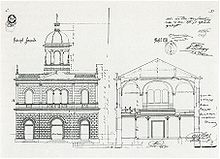Gymnastics temple
Coordinates: 48 ° 11 ′ 32 ″ N , 16 ° 20 ′ 7 ″ E
The Turner Temple was a synagogue on Turnergasse 22, 1892. 15 in the new eingemeindeten Viennese district Fünfhaus and since October 15, 1938 part of today's 15th district Rudolfsheim-Fünfhaus . The free-standing synagogue was built by the Jewish community in the district from 1871 to 1872 and destroyed by the National Socialists during the November pogroms (called Reichskristallnacht by the National Socialists ).
Building history
The building was designed by Karl König in the style of the Italian Renaissance with 496 seats for men and 333 seats for women. In 1923 a total exterior and interior renovation was carried out at a cost of 170 million crowns , which was entirely raised by donations from the community members. In addition, the prayer room, which had become too small, was replaced by a larger extension.
The heiress of the Klimt paintings, Maria Altmann , married in this synagogue.
destruction
During the November pogroms of November 9-10, 1938, this synagogue was also destroyed by fire at dawn on November 10th (the parish hall behind it remained undamaged). Only one of the 93 synagogues in Vienna survived these days, albeit with severe damage: the city temple in the 1st district, which reopened in 1963 . On December 1, 1939, the Israelitische Kultusgemeinde issued a notice of approval to demolish the ruins of the gymnastics temple; the deadline was set in 1941 and kept.
Later uses
In May 1940, Leopold Hölzl, a transport company from the 15th district, “Aryanized” the property at a purchase price of 38,500 Reichsmarks. The restitution proceedings ended in 1947 with a settlement; The property remained in the possession of the Hölzl family, who operated a garage with a gas station on it and sold it to the City of Vienna in 1973. Between 1976 and 1979, they built a residential complex on the building site of the former parish hall; the area on which the synagogue itself stood remained undeveloped: “a fenced-in piece of meadow”. In 1988, a "memorial plaque under exclusion of the public" was attached to the community building in a place that was hardly visible to passers-by.
As part of the Herklotzgasse 21 project, a competition for the design of a monument was held together with the City of Vienna and the Board of Trustees for Art in Public Space (KÖR). The winners of the competition, which was not aimed at a Holocaust memorial in the traditional sense, but rather aimed at remembering the history of the place and meeting today's population, were the team Iris Andraschek & Hubert Lobnig / Auböck + Kárász . Your design has been implemented. On November 10, 2011, the Turnergasse memorial site was finally opened.
On November 7, 2018, the place on which the temple stood was named after Moshe Jahoda , who was instrumental in the implementation of the memorial site.
swell
- ↑ Michael Kofler, Judith Pühringer, Georg Traska (eds.): The triangle of my childhood. A Jewish suburban community in Vienna , Mandelbaum-Verlag, Vienna 2008, ISBN 978-3-85476-279-9 , pp. 96 and 179
- ↑ Opening of the "Turnertempel" memorial site
- ↑ Maren Häußermann: "Grandpa, I hope you're watching" . In: Stadtleben - Wiener Zeitung Online . ( wienerzeitung.at [accessed on November 9, 2018]).
See also
literature
- Pierre Genée: Vienna Synagogues 1825–1938 . Löcker, Vienna 1987, ISBN 3-85409-113-3 .
- Michael Kofler, Judith Pühringer, Georg Traska (eds.): The triangle of my childhood - a Jewish suburban community in Vienna . Mandelbaum Verlag, Vienna 2008, ISBN 978-3-85476-279-9 .
- Bob Martens , Herbert Peter: The destroyed synagogues of Vienna. Virtual city walks . Mandelbaum Verlag, Vienna 2009, ISBN 978-3-85476-313-0 .



